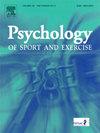Cognitive and executive functions of top level para-karate athletes with intellectual disability
IF 3.3
2区 心理学
Q2 HOSPITALITY, LEISURE, SPORT & TOURISM
引用次数: 0
Abstract
Karate is one of the most popular martial arts. This study investigates the cognitive profiles of top-level Para Karate athletes with intellectual disability (ID), aiming to assess the extent to which cognitive abilities are related to athletic performance. Cognitive and executive functions, including decision-making, processing speed, working memory, cognitive flexibility, and inhibitory control, are critical in high-level sports but are often understudied in athletes with ID. We conducted cognitive assessments and executive function tests on a cohort of elite Para Karate athletes (n = 42) aged 27.0 (±6.5) years competing in two separate classes. The K21 class (n = 21) is the traditional class for athletes diagnosed with ID and the K22 (n = 23) is a class for ID-athletes with a significant additional impairment such as a genetic syndrome (e.g., Down syndrome) or functional limitation (e.g., reduced joint mobility). The MANOVA revealed that K21 Para Karate athletes perform significantly better than K22 athletes in the areas related to cognitive processing speed (i.e., simple reaction time), visuospatial processing (block design) and inductive reasoning (matrix reasoning task) with large effect sizes. No significant differences between the classes were found for the executive function measures working memory and inhibitory control. The kata-performance during competition was judged by a panel of seven referees. K21 athletes performed better than K22 athletes and a significant correlation was apparent between kata-performance and one parameter of executive function (i.e., inhibitory control). These results highlight the relation between cognitive development and martial arts performance and provide insights for future studies related to the development of sport-specific classification for athletes with ID. More sophisticated measures are necessary to assess the key determinants of kata performance.
高水平智障辅助空手道运动员的认知和执行功能。
空手道是最流行的武术之一。本研究调查了智力残疾的顶级Para空手道运动员的认知特征,旨在评估认知能力与运动成绩的关系程度。认知和执行功能,包括决策、处理速度、工作记忆、认知灵活性和抑制控制,在高水平运动中是至关重要的,但在ID运动员中往往没有得到充分的研究。我们对一组年龄27.0(±6.5)岁的优秀Para空手道运动员(n = 42)进行了认知评估和执行功能测试。K21类别(n = 21)是诊断为ID的运动员的传统类别,K22类别(n = 23)是患有明显额外损伤的ID运动员的类别,如遗传综合征(如唐氏综合征)或功能限制(如关节活动能力降低)。方差分析结果显示,K21 Para空手道运动员在认知加工速度(即简单反应时间)、视觉空间加工(块设计)和归纳推理(矩阵推理任务)相关领域的表现显著优于K22运动员,且效应量较大。在执行功能测量、工作记忆和抑制控制方面,班级间无显著差异。比赛期间的花式表演由七名裁判组成的小组进行评判。K21运动员的表现优于K22运动员,K21运动员的表现与执行功能的一个参数(即抑制控制)之间存在显著相关。这些结果突出了认知发展与武术表现之间的关系,并为ID运动员专项分类发展的相关研究提供了见解。更复杂的措施是必要的,以评估关键决定因素的型表现。
本文章由计算机程序翻译,如有差异,请以英文原文为准。
求助全文
约1分钟内获得全文
求助全文
来源期刊
CiteScore
6.40
自引率
5.90%
发文量
172
审稿时长
69 days
期刊介绍:
Psychology of Sport and Exercise is an international forum for scholarly reports in the psychology of sport and exercise, broadly defined. The journal is open to the use of diverse methodological approaches. Manuscripts that will be considered for publication will present results from high quality empirical research, systematic reviews, meta-analyses, commentaries concerning already published PSE papers or topics of general interest for PSE readers, protocol papers for trials, and reports of professional practice (which will need to demonstrate academic rigour and go beyond mere description). The CONSORT guidelines consort-statement need to be followed for protocol papers for trials; authors should present a flow diagramme and attach with their cover letter the CONSORT checklist. For meta-analysis, the PRISMA prisma-statement guidelines should be followed; authors should present a flow diagramme and attach with their cover letter the PRISMA checklist. For systematic reviews it is recommended that the PRISMA guidelines are followed, although it is not compulsory. Authors interested in submitting replications of published studies need to contact the Editors-in-Chief before they start their replication. We are not interested in manuscripts that aim to test the psychometric properties of an existing scale from English to another language, unless new validation methods are used which address previously unanswered research questions.

 求助内容:
求助内容: 应助结果提醒方式:
应助结果提醒方式:


